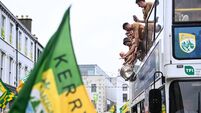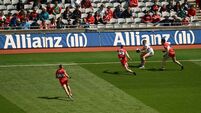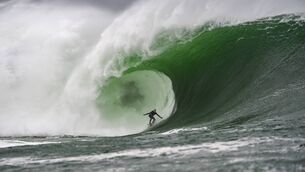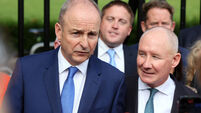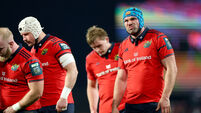The history of the split that will see two Irish teams at #Euro2016

But it is also the result of a frenetic battle for control of soccer in Ireland between the Football Association of Ireland (FAI) based in Dublin, and the Irish Football Association (IFA) based in Belfast.
This is a tangled history that reaches back even to the very origins of the playing of soccer in Ireland.
The IFA – which controlled soccer in Ireland from the early 1880s onwards – was dominated from the start by Belfast-based administrators. This was a consequence of the early dominance of that city as the focal point of the spread of the game into Ireland during the 1880s and of the power of its professional clubs from the 1890s onwards.
This Belfast dominance of soccer assumed a new significance in the wake of war and revolution in the years between 1912 and 1923.
For the men who loved soccer in southern Ireland, the sense that their game was run by unionists was inescapable and in the light of rising nationalist sentiment after 1916 this was to prove a significant point of contention.
This was particularly the case because of the spectacular growth of the game in Dublin in the early 20th century. The game in Dublin was locally run by the Leinster Football Association and it was the men from this Association who led the establishment of the Football Association of Ireland in June 1921 – the context of war, revolution and – ultimately – the partition of Ireland had obvious consequences. Their headquarters and, ultimately, their powerbase would be Dublin.
A letter from Dublin to Belfast confirmed disaffiliation from the IFA. The practicalities of separation were immediately apparent. In June, the Football League of Ireland was established and eight Dublin-based clubs were admitted for its first season. Then, on 2 September 1921, the Football Association of Ireland held its first meeting in Dublin.
There were now two associations vying to control soccer in Ireland as both the Dublin-based FAI and the Belfast-based IFA initially claimed to legislate for soccer across the entirety of the island – and neither recognised the existence of the other.
Something of a working compromise emerged in time in terms of the internal leagues and cups – the IFA controlled internal competitions north of the border and the new FAI performed the same function in the south. While the transition to this new arrangement could not be described as seamless and certainly was not harmonious, it was nonetheless relatively clear.
What proved much more difficult was international recognition. In this respect, two bodies were crucial: the International Football Association Board (IFAB) and the Fédération Internationale de Football Association (FIFA).
The IFAB had been in existence since 1886 and comprised the Football Associations of England, Scotland, Wales, and Ireland.
It was never broadened to include countries outside the United Kingdom, even though the spread of soccer had led to the steady growth in international soccer matches, particularly on continental Europe.
Attempts to get the International Football Association Board to reflect this new dynamic were rejected and, in response, the Football Associations of France, Belgium, Denmark, Netherlands, Spain, Sweden, and Switzerland established FIFA on 21 May 1904.
Although essentially boycotted by the teams that comprised the International Board until after the Second World War, FIFA steadily grew in importance. This importance accelerated following the successful staging by FIFA of a soccer competition as part of the Paris Olympics in 1924. This led on to the staging by FIFA of a World Cup for the first time in 1930.
In the tangled aftermath of the partition of Irish soccer in the early 1920s, the Dublin-based FAI embarked on a tortuous set of negotiations with the International Football Association Board in an attempt to secure recognition.
Initial applications for acceptance were rejected after the Belfast-based IFA successfully blocked the move. Their logic was straightforward: ‘no country could be represented by two Associations’.
Even as those negotiations were proceeding, the Dublin-based FAI also sought recognition from FIFA; this was duly achieved in September 1923 when FIFA informed the FAI that it was willing to accept the membership of the FAI. That FIFA was organising a soccer tournament for the Paris Games in 1924 offered the possibilities of an Irish Free State team taking part.
The Irish Free State government had already given its approval to the FAI and recognised it as the governing body for soccer in Ireland. Now, it acquiesced in the inclusion of an FAI-organised Irish team as part of the Irish Olympic team for the Paris Olympics.
Funding the team was the next challenge: a match played in Dalymount Park between a League of Ireland team and Glasgow Celtic drew 22,000 and cleared £250. Trial matches held in Dublin in April and May 1924 led to sixteen players drawn from four League of Ireland clubs (Athlone Town, Bohemians, Brooklyn, and St James’s Gate) selected to travel to Paris; the stringent Olympic rules on amateurism ruled out many players worthy of making the team.
The Irish team wore blue jerseys on which a spray of shamrock sat on a white shield. And they walked onto the pitch to the sounds of Thomas Moore’s ‘Let Erin Remember’.
In the end, victory over Bulgaria was followed by defeat to Holland; it was a creditable performance by a team in its first outings. What mattered more than the results was the symbolism of the moment; the Irish Free State now had its own soccer team competing on the international stage.
The new Ireland team was unable to secure a regular diet of international matches, however. As it turned out, the FAI’s team – playing as Ireland – did not get to play England until 1946, Wales until 1960, Scotland until 1961, and Northern Ireland until 1978. The reason for this was straightforward – the IFA in Belfast effectively blocked such money-spinning matches from happening for their Dublin rivals.
The use of the name ‘Northern Ireland’ for the team representing the IFA from Belfast was, itself, promoted by FIFA from the 1920s onwards but remained unaccepted by the IFA until well after the Second World War, who continued to call themselves Ireland.
Indeed, the IFA regarded the FAI as usurpers and frequently revealed their views on the matter, including in a 1954 memorandum: ‘The Irish FA functioned harmoniously until a political movement inspired by a religious element caused a re-adjustment of relations between Ireland and the British Government’.
For its part, the FAI repeatedly complained to FIFA that the part of Ireland ‘still held as part of the UK’ was using the name ‘Ireland’ when it should properly be calling itself ‘Northern Ireland’.
The upshot was that both the FAI and IFA fielded teams known as ‘Ireland’ and, despite the urgings of FIFA, both freely chose players from either side of the border in Ireland.
Indeed, before 1950 more than 40 players lined up for Ireland teams selected by both competing soccer bodies.
For the IFA Ireland team, there was an annual round of ‘Home’ Internationals against England, Scotland, and Wales, while they also played touring teams such as the visiting South Africa team in 1924.
Down south, the difficulties that the FAI had in establishing itself can be seen by the fact that after the Paris Olympics the FAI Ireland team averaged just a single game a year between then and 1934.
In ’34 the FAI Ireland team began to enter into qualifying matches for the World Cup. It was unsuccessful in this campaign and again in attempting to qualify for the 1938 World Cup. The very fact of competing, however, was emblematic of the success that the FAI began to have in at least establishing recognition for itself on the international stage.
There were periodic attempts to heal the divide between north and south. Linfield played Bohemians in an annual match between 1923 and the mid-1940s, for example, and there was later an interleague series of representative matches and the annual university soccer competition was all-island.
There were also occasional negotiations between the FAI and the IFA aimed at finding a way to unite soccer in Ireland. None succeeded. The closest miss in the attempt to find a solution came in 1932.
So close was the miss that the Irish Independent actually announced in March 1932 that ‘football unity’ had been secured with the FAI and the IFA agreeing to a sort of federal agreement on the organisation of the domestic game, with a joint- committee chaired in alternative years by men from either side of the border running an all-Ireland international team.
The agreement – which would have seen all gate receipts shared evenly from matches that would be played alternately in Dublin and Belfast – seemed to be in place, then collapsed over FAI demands for representation on the IFABoard; the IFA wished to retain both the ‘Ireland’ seats in the Board.
Amid the fallout from the failed negotiations, relations between the two bodies ‘were reduced to outright animosity’. And the more time passed, the more entrenched became the divides between the IFA and the FAI in terms of their spheres of influence.
This became clear in the selection of the two ‘Ireland’ teams. The most famous of the players to have played for both teams was the captain of Manchester United, Johnny Carey. He won seven caps with the IFA Ireland team, 28 caps with the FAI Ireland team and captained both. It was a singular feature of the absurd system which emerged that Carey played for the IFA Ireland team against England at Windsor Park on 28 February 1946 and did the same for the FAI Ireland team at Dalymount Park two days later.
Carey retired in 1949, the same year that the Republic of Ireland came into being in Dublin. de Valera’s 1937 constitution had created a republic in all but name, and this was then formalised in the Republic of Ireland Act passed by Dáil Éireann in April 1949.
It was one thing to play in friendly matches, but it now became untenable that players should be selected for both the IFA and the FAI selections for the same tournament.
A solution was now imperative – and it was eventually brokered whereby the IFA fielded its team as Northern Ireland and the FAI fielded its team as the Republic of Ireland. And, crucially, the practice of claiming jurisdiction over players from across the island ended with players now restricted to playing for one team or the other.
There was one other essential element to the agreement – the idea of fielding a single team to represent Ireland on the international stage was pushed further and further from reach.






